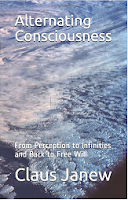In What is Consciousness? (I) we considered the formation of i-structures through
circumscription, and in What is Awareness? (I) the alternation of perspective
as such. But basically both are one and the same.
Circumscribing
movement - consciousness - is of course an alternation of individual points of
view. And the perception of an alternation - awareness - also circumscribes a
constant center. The difference between emphasized
circumscription and emphasized alternation
lies in the density of the circumscribed central area. If the circumscribing
alternation (for example, between facades) forms an object (a house), the
content-dense center symbolizes its unity ("being inside"). If the
alternation is perceived more as such, the object character is thin ("Is
it several houses or one?").
The maximum of unity is in the intuitive center point, while the maximum of alternation is in the alternation itself. That is, the alternation is authoritative and the circumscription is derived. (Without facades, there is no interior.)
Now,
however, the "trace" of the alternation (of the facade run) is more
or less wound up in the memory, that is, condensed, and the respective
awareness is only incompletely conscious
of the entire alternation (for example, between three bare walls with corners
and a few windows). The rest (more windows, attic, back wall) leads into the
just not conscious, into a narrowing.
Awareness
includes consciousness of this transition ("closer, behind"). But consciousness
is in a sense the "upper" part of awareness, while awareness as such
also includes the just not conscious "further down" by alternating with it. This is more than a
point transition or a coagulated potential. From the alternation between conscious
and subconscious, awareness "receives," so to speak, impressions and
inklings that escape the more static consciousness ("a chamber
somewhere").
All in all,
consciousness resembles a funnel, the rim of which represents the
circumscribing (alternating) movement, which condenses and narrows inward and
merges with the funnel stem into the just not conscious. Only the center point
of the whole movement remains conscious. Awareness, on the contrary, follows the stem to the other side
("to the back, around the corner"), i.e. it changes over there into
the consciousness whose stem leads
back again.
The
difference is not strict: Consciousness is always awareness! Awareness is also
conscious, but it points beyond and always includes more than what is currently conscious. Alternation cannot be
approximately fixed. With consciousness we only try to ignore it, and then its
own changeable nature slips away from us, the awareness from which it
"spirals out".
The
connection between awareness and consciousness was also pointed out in
Individuality and Reality: Through the alternation of individual perception, a
common approximation is constructed,
a conscious reality (a rolling pen, a house). Since the alternating coiling is
condensed during the formation of the approximation and the alternating
standpoints "disappear" in the funnel stem, we do not overlook the
formation of reality. However, since consciousness always creates approximate commonalities, the consciousness funnel
is a reality funnel. It creates reality out
of the funnel stem by approximating individualities to one consciousness, but at no
point by relinquishing them. Everything remains awareness.
Some aspects may also become clear from the following figures:
Figure 1: Above, the circumscribing condensation in the reality funnel is shown. Below, a possible top view shows how the alternation of perspective condenses into an apparently static object consciousness.
Figure 2: This is a summary and further simplification of Figure 1. This time I have emphasized the overall movement of perspective and the resulting spatial object awareness.




